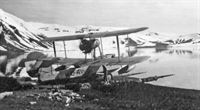Фотографии
-
The first of the AN’s Walruses was M-O-9, which made its first flight at Eastleigh with the B Conditions marking N-15 in April 1938. The first two Argentinian Walruses were built specifically for the AN and both were transported to Buenos Aires aboard the Vickers-Armstrongs-built cruiser ABA La Argentina during early 1939.
Самолёты на фотографии: Supermarine Walrus/Seagull V - Великобритания - 1933
-
In January 1947 Walrus 2-O-24 was loaded aboard the transport ship ARA Patagonia, which then set sail southwards towards the Antarctic to undertake the Primera Gran Expedicion Antartica. The Walrus was offloaded at Deception Island, where it is seen here, and from where it made its first survey flight on January 31.
Самолёты на фотографии: Supermarine Walrus/Seagull V - Великобритания - 1933
-
With the low Antarctic sun casting shadows in the cockpit, Walrus M-O-4 is hoisted on to its cradle aboard ARA Pampa during the 1947-48 Naval Antarctic Campaign. The Walrus I was built with a metal hull, but the Mk II, built by Saunders-Roe, incorporated a wooden hull to free up wartime stocks of priority light-alloy materials.
Самолёты на фотографии: Supermarine Walrus/Seagull V - Великобритания - 1933
-
Walrus Mk 12-O-23 was the first of the second batch to be acquired by the Aviacion Naval, all eight of these having been former RAF examples bought back by Supermarine for refurbishment and sale. It is seen here at Hamble with Argentinian crew members during acceptance flights.
Самолёты на фотографии: Supermarine Walrus/Seagull V - Великобритания - 1933
-
A crewman places himself on the upper wing of Walrus M-O-4 either before attaching the ship’s crane hook to the aircraft or having just released it. This aircraft made its second expedition to the Antarctic in February 1948 when it was sent back to Deception Island as part of a task force despatched to assert Argentinian sovereignty.
Самолёты на фотографии: Supermarine Walrus/Seagull V - Великобритания - 1933
-
In January 1947 Walrus 2-O-24 was loaded aboard the transport ship ARA Patagonia, which then set sail southwards towards the Antarctic to undertake the Primera Gran Expedicion Antartica.
Самолёты на фотографии: Supermarine Walrus/Seagull V - Великобритания - 1933
-
Walruses M-O-9 and M-O-10 on public display at Puerto Belgrano, 435 miles (700km) south of Buenos Aires. The markings incorporated the AN’s anchor motif on the upper wing surfaces and on the undersurfaces of the lower wing, with the individual code number painted on the upper surface of the upper wing centre section.
Самолёты на фотографии: Supermarine Walrus/Seagull V - Великобритания - 1933
-
Built by Vickers-Armstrongs at Barrow-in-Furness, ARA La Argentina was a light cruiser designed for training naval cadets. It was launched on March 16, 1937, although it was not completed until January 1939, owing to the pressing demands of Britain’s rearmament programme. Note the Walrus on its catapult.
Самолёты на фотографии: Supermarine Walrus/Seagull V - Великобритания - 1933
-
In 1943 Argentina defined its Antarctic territory as between 25°W and 74°W, south of 60°S, which included Deception Island, the safest natural harbour in Antarctica, located at 60°W, 63°S - and thus much disputed by the various nations that had visited. Here M-O-4 is seen on the shore of the island’s volcano caldera during the 1947-48 Argentinian expedition.
Самолёты на фотографии: Supermarine Walrus/Seagull V - Великобритания - 1933
-
The second batch of former RAF Walruses were initially finished in a two-tone primer scheme, with their B Conditions markings applied to the bow of each. Here Walrus 2-O-29, still bearing its B Conditions marking N-39, is prepared for delivery at Eastleigh. The rudder had pale blue and white stripes applied, along with the Sol de Mayo national emblem.
Самолёты на фотографии: Supermarine Walrus/Seagull V - Великобритания - 1933
-
A place for everything and everything in its place - a dismantled Walrus packed away in its crate for shipping. Other military operators of the Walrus/Seagull V included Turkey, Australia, the Irish Air Corps, Canada, New Zealand and one aircraft to Egypt.
Самолёты на фотографии: Supermarine Walrus/Seagull V - Великобритания - 1933
-
Over she goes! Walrus 7-O-6 sustained considerable damage after overturning on landing at BA Comandante Espora on October 12, 1953. It was, however, still deemed worthy of repair and served for another five years before finally being struck off charge in 1958.
Самолёты на фотографии: Supermarine Walrus/Seagull V - Великобритания - 1933
-
During 1936-39 the AN updated its fleet-spotter reconnaissance capabilities with the acquisition of two batches of Grumman Duck amphibian biplanes, a formation of which is seen here, and which were used alongside the AN's pair of Walruses.
Самолёты на фотографии: Grumman JF / J2F Duck - США - 1933
Статьи
- -
- A.Delalande - All the president's men
- C.Gibson - What is Rechlin 104? Germany's mystery cargo aircraft
- C.Higgs - Proof positive
- E.Bryan - A lot less bother by hover!
- L.Gaylard - The fall of Damien
- M.Bearman - Tunnel vision
- M.Willis - "Very nearly a good aeroplane..."
- N.Stroud - Off to Butlin's /The John Stroud Archive/
- P.Davidson - Off the Beaten Track...
- P.Jarrett - Lost & Found
- P.Jarrett - Sidney Camm's long-lost triplane
- R.Lezon - The Walrus in Argentina
- R.Mulder - Crossing the Deep
- R.Riding, A.Stephenson - What a woman! Janet Ferguson: ferry pilot extraordinare
- T.Buttler - TSR.2's company: Hawker P.1129












